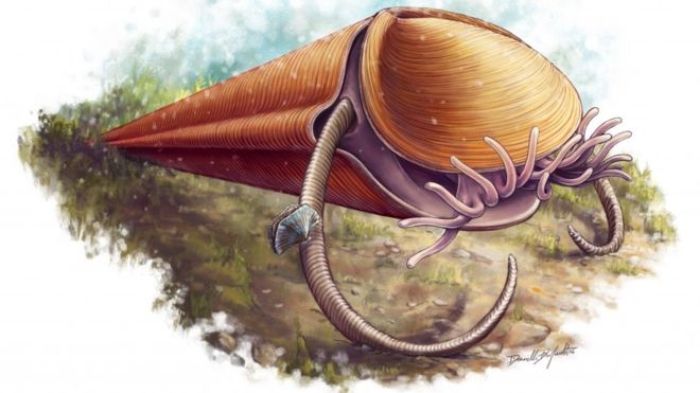Scientists Identify Bizarre 500 Million Year Old Sea Creature
A bizarre group of extinct cone-shaped animals that lived on the ocean floor 530 million years ago have been successfully identified and conferred a place on the tree of life.

Known as hyoliths, these tiny marine creatures which evolved over 530 million years ago during the Cambrian period, have eluded scientific classification since the first fossil was discovered 175 years ago.
The extinct creatures had a hard cone-shaped shell enclosing a soft body with tentacles for feeding and appendages that acted as "feet".
Earlier thought to be a part of the mollusc family which includes snails and squids, hyoliths have now been identified as close relatives of brachiopods -- a group of marine animals that have hard "valves" (shells) on the upper and lower surfaces, unlike the left and right arrangement found in molluscs. The group of scientists responsible for this discovery published their findings in the scientific journal Nature on January 11.
"Our most important and surprising discovery is the hyolith feeding structure, which is a row of flexible tentacles extending away from the mouth, contained within the cavity between the lower conical shell and upper cap-like shell," said study lead Joseph Moysiuk, a 20-year-old University of Toronto undergraduate student. "Only one group of living animals -- the brachiopods -- has a comparable feeding structure enclosed by a pair of valves. This finding demonstrates that brachiopods, and not molluscs, are the closest surviving relatives of hyoliths.
The discovery was made after the team of scientists analysed 1,500 fossil specimens recovered near the Burgess Shale in British Columbia, Canada -- a part of the Canadian Rocky Mountain Parks World Heritage Site which is a renown fossil hotbed with prehistoric remains dating back more than 500 million years.
Mr. Moysuik and his team succeeded were previous paleontologists had failed because some of the samples they analysed had preserved soft tissue. Typically, only hard parts of an organism such as its teeth, bones or shells are fossilized, but the soft tissue discovered in the hyolith fossils was instrumental for their classification, reports the New York Times.
The correct identification of hyoliths and their allocation to the tree of life allows scientists to have a better idea of animal life in prehistoric oceans. It also improves understanding of mass extinction events such as the Permian-Triassic event -- Earth's most severe case of mass extinction that wiped out 96 percent of all marine species including the hyoliths.
"Understanding the effects of such mass extinctions on ecology and diversity is particularly important as we seek to appraise and mitigate the implications of the current mass extinction event brought about by human activity," said Dr Martin Smith of the University of Durham, UK, who also worked on the fossils, in an interview with BBC News.



























